Ujir Singh Thapa
| Sri Colonel Kaji Ujir Singh Thapa | |
|---|---|
|
श्री कर्णेल काजी उजीर सिंह थापा | |
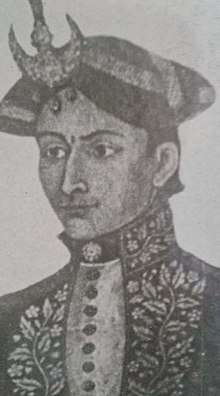 Colonel Ujir Singh Thapa Kaji wearing noble attire at young age | |
| Governor of Palpa Gauda Province | |
|
In office 8th Mangshir, 1871 B.S.[1] – circa 1825 | |
| Preceded by | Amar Singh Thapa |
| Personal details | |
| Born | Chaitra, 1852 Bikram Samwat (1796 A.D.) |
| Died |
20th Mangshir, 1881 B.S. (aged 29)[1] Aryaghat, Kathmandu |
| Relations |
Bhimsen Thapa (uncle) Ranajit Pande (maternal grandfather) Queen Tripurasundari of Nepal (sister) Mathabarsingh Thapa (brother) Jung Bahadur Rana (nephew) |
| Mother | Rana Kumari Pande |
| Father | Nain Singh Thapa |
| Signature |
 |
| Military service | |
| Allegiance |
|
| Rank | Colonel (Nepali convention) |
| Battles/wars | Anglo-Nepalese war |
Ujir Singh Thapa or Uzir Singh Thapa (Nepali: उजीर सिंह थापा) also known as Wazir Simha Thapa was Nepalese administrator and military officer. He was the military commander at the Palpa-Butwal axis during the Anglo-Nepalese War.
Family and Early Life
Ujir Singh was born on Chaitra Shukla Pratipada Tithi in the year 1852 of Bikram Samvat (1796 A.D.).[1] He was the son of Kaji Nain Singh Thapa and grandson of Sanu Sardar Amar Singh Thapa.[2] His grandfather died on 7th Kartik 1871 B.S. He traveled 20 days from Kathmandu to Palpa and took the control of the office of Governor of Palpa Gauda (Province) on 8th Mangshir, 1871 B.S. aged 19 years old.[1]
Military and administrative career
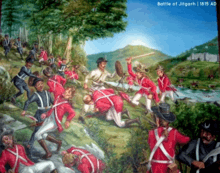
He was Colonel[note 1] in the ranks of Nepalese Army and was awarded an official private black seal which can be seen in the letter of 1821 A.D. to the Mukhtiyar Bhimsen Thapa.[4] He was the military commander at the Mid-Western (Palpa-Butwal) axis during the Anglo-Nepalese War. He had deployed 1200 troops in defenses of Jit Gadhi, Nuwakot Gadhi, and Kathe Gadhi. He was famous for exploiting an advantage in men, material, natural resources and well versed in mountain tactics.[5] Henry Thoby Prinsep quoted about the Jeetgadh administered by Ujir Singh as :
....that Goorkhas under Colonel Wuzeer Singh, a nephew of Bheem Sein's, had taken post at the mouth of the pass, within which Bootwul is situated, and had built there a stockade called Jeetgurh, it was resolved to reconnoitre the works, and carry them, if possible, before processing further.[6]
The British advance began on 22 Poush, 1871 B.S.(January 1814 A.D.) to Jit Gadhi. While crossing Tinau River to attack the fortress Ujir's forces opened the fire and made them fall back. Similarly, at Tansen Bazaar the British fell back with a total loss of 300 men while 70 Nepalese lost their lives.[5] In 1825, a complaint of border incursions was lodged at the jurisdiction of Ujir Singh's administration. Such was done to oppose the Mukhtiyar Bhimsen Thapa in the policy of forging alliance with the Burmese government.[7]
Gallery
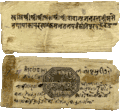 Ujir Singh Thapa's letter to his uncle Mukhtiyar Bhimsen Thapa whom he refers to in the cover of letter as Babajyu Janaral (Father General);
Ujir Singh Thapa's letter to his uncle Mukhtiyar Bhimsen Thapa whom he refers to in the cover of letter as Babajyu Janaral (Father General); Ujir Singh Thapa
Ujir Singh Thapa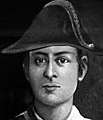 Colonel Ujir Simha Thapa
Colonel Ujir Simha Thapa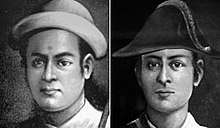 Colonel Ujir Simha Thapa and his first cousin Captain Balbhadra Kunwar both fought in Anglo-Nepalese War
Colonel Ujir Simha Thapa and his first cousin Captain Balbhadra Kunwar both fought in Anglo-Nepalese War
References
Footnotes
- ↑ The use of English terms for their grades of command was common in the Nepalese army, but the powers of the different ranks did not correspond with those of the British system. The title of General was assumed by Bhimsen Thapa, as Commander-in-chief, and enjoyed by himself alone; of Colonels there were three or four only; all principal officers of the court, commanding more than one battalion. The title of Major was held by the adjutant of a battalion or independent company; and Captain was the next grade to colonel, implying the command of a corps. Luftun, or Lieutenant, was the style of the officers commanding companies under the Captain; and then followed the subaltern ranks of Soobadar, Jemadar, and Havildar, without any Ensigns.[3]
Notes
- 1 2 3 4 http://annapurnapost.com/news-details/70416
- ↑ Acharya 2012.
- ↑ Prinsep 1825, pp. 86-87.
- ↑ http://www.bilder-aus-nepal.de/Pages/Philatelie/Thapa-Brief/Thapa-Brief-1821.html
- 1 2 "Nepalese Army | नेपाली सेना". Nepalarmy.mil.np. Archived from the original on 2011-06-07. Retrieved 2016-10-06.
- ↑ Prinsep 1825, p. 115.
- ↑ Pradhan 2012, p. 116.
Bibliography
- Acharya, Baburam (2012), Acharya, Shri Krishna, ed., Janaral Bhimsen Thapa : Yinko Utthan Tatha Pattan (in Nepali), Kathmandu: Education Book House, p. 228, ISBN 9789937241748
- Pradhan, Kumar L. (2012), Thapa Politics in Nepal: With Special Reference to Bhim Sen Thapa, 1806–1839, New Delhi: Concept Publishing Company, p. 278, ISBN 9788180698132
- Prinsep, Henry Thoby (1825), History of the political and military transactions in India during the administration of the Marquess of Hastings, 1813-1823, Vol 1, Kingsbury, Parbury & Allen